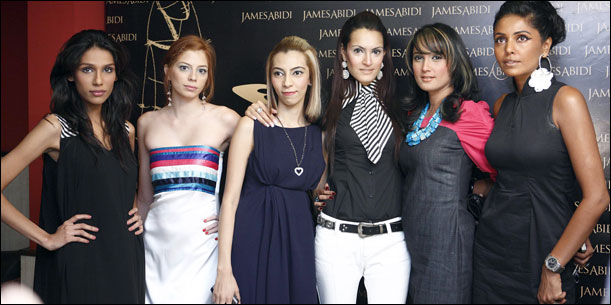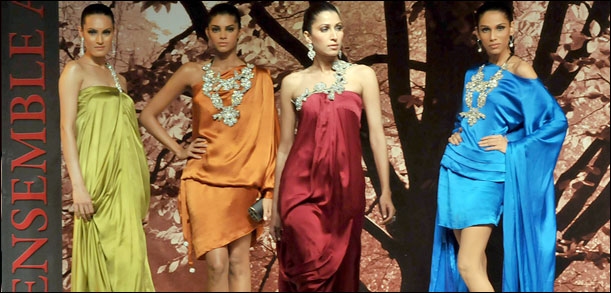|
|
| |
instep
analysis
Taking stock of fashion
Pakistan's fashion industry has grown immensely in the past few
years but for the number of high profile designers around, there
is surprisingly little choice when it comes to availability of collections
and clothes. Instep talks to designers and fashion retailers to
find out whether it's a disappearing act or just a case of low capacity…
By Saba Imtiaz
|
| |
 |
| |
The
Pakistani fashion scene has come a long, long way, most notably
in the past few years. Where designer collections were relegated
to the glossy pages of magazines and newspaper shoots, they have
now come alive in shops where one can peruse and purchase the same
clothes that have been modelled by Pakistan's top models in shoots
and at glitzy fashion shows.
Multi label retail stores have come along with the growth of the
industry. These stores stock lines by a number of designers, and
prominent examples abroad include Barney's and Harvey Nichols. However
at home, over the past few months the clothes seem to be nowhere
and the designers every where but on the retailers' racks. The intent
of designers to stock at retailers was to give them a presence in
the market without having potential customers go through the 'by
appointment only' option as well as to launch their names under
the aegis of an already established retail name. To their clients,
it was giving the provision of easy and off the rack options.
Only the equation hasn't always been this smooth. Right after the
launch of designer(s) at a particular retailer, whether it is through
a launch event or a fashion show heralding their arrival, the racks
appear to be stocked. Then they begin to dwindle, and while one
can see their creations in shoots, they're not in the stores. The
question is then: is fashion really accessible?
It is unfortunate that the answer is no. For those who peruse the
racks of retailers in Karachi regularly, the outfits that are available
are from collections that came out months, and in some cases, even
years ago. Most pieces have no semblance to a seasonal collection
and have no hallmark of a design philosophy at times. The outfits
have been showcased in shoots and the social pages to death for
months at a stretch and so when one does go to a retailer, the selection
at hand is anything but appealing.
Labels was the first multi-label store in Karachi that began stocking
prêt lines by designers. But over the past few years so many
have come and gone - including Maheen Khan, Deepak Perwani, Nomi
Ansari and Zara Shahjehan - that it has been hard to keep track
of where those designers actually stock now. Labels currently stocks
Maheen Karim, Jamie Abidi, Jannat and Sadaf, Sadia-Nadia as well
as their in-house line. Maheen Karim, who stocks at Labels in Karachi
as well as at The Boulevard in Lahore and Soiree and Source in Dubai,
seems to be entirely missing from Labels most of the time. One can
usually only see a limited number of new pieces available at her
space at Labels and ever since the store has been undergoing renovation,
that presence is minimal.
According to retailer Zahir Rahimtoola, "Designers begin with
their collections and the sales kick off, but after a certain period
of time the frequency of collections drops. Maheen Karim for example,
consistently stocked at Labels. But with time and now that she's
stocking in Lahore and Dubai the inventory has gotten stretched
though she has said that new stock will be in by February 15. The
same is with Jamie - it's a small operation and she needs to manage
it herself as well as do the financial input, and she's also stocking
at Mélange in Islamabad, so her priority was to stock there
as well."
|
| |
 |
| |
"I only keep a capsule collection at all the places I stock at,"
explains Maheen Karim. "I am continuously producing and do not
keep more than a few select pieces at the stores so that people can
see my collection properly. Even at the stores in Dubai, we never
have anything that is exactly the same so that there is variety."
Jamie says that she restocks based on demand for her outfits. But
while one saw a shoot for her collection that was completely missing
from her rack at Labels even a day after the shoot was printed, it
made me ask Jamie how accessible her collection really is. Jamie was
swift to point out that shoots of her collections that have been carried
in print were actually done eight months prior to when it was printed,
and carried shots of clothes that would be part of her (as yet unannounced
and unavailable) high end prêt line.
Ensemble, a higher end fashion boutique in Karachi, started a new
precedent of doing seasonal shows to mark the launch of new collections
by designers that stock there. However, while one would think that
the new collections would be in the store after the show, it isn't
always so. After the Autumn/Winter show, which showcased Bunto Kazmi,
Rizwan Beyg, Sana and Safinaz and Adnan Pardesy, the collections were
not available.
Rizwan Beyg's My Fair Lady-inspired collection wasn't available but
an Eid one was that reportedly did not sell well. The show was also
much hailed for the full-fledged runaway debut of Pakistan's top couturier
Bunto Kazmi's prêt line, but one can now only find a minimum
number of outfits by her at Ensemble. (Bunto was out of the country
at the time this article was written and could not be contacted for
information.)
Zeba Husain, who manages the store with her daughter Shehrnaz, says
"Bunto's collection after the show sold out in a day, and since
then she's been restocking but it's been a bit slow after the wedding
season."
Sana and Safinaz, who were reported to be stocking the collection
at Ensemble that they showed at the show, are instead designing a
separate collection for Ensemble that will be available at the store
in the weeks to come. Adnan Pardesy, who was also expected to stock
a more wearable collection, is still not available at the store and
it is unsure when his collection will come in. It has been over four
months since the fashion show introduced them all to the store.
Sadaf Malaterre, who exclusively stocks at Ensemble, hit the nail
on the head by saying that while she feels that one should only commit
to several places when one has the capacity to not only be able to
produce, but also design it.
Kamiar Rokni, the only Lahore-based designer to be stocking at Ensemble
also restocks based on demand as well and does mini-lines of seasonal
collections so that there is "an injection of new designs and
varieties". However one hasn't seen a full-fledged seasonal collection
since the designer struck solo over a year ago.
In this run of fashion retailers, it appears that Asad Tareen of The
Designers has got it relatively better as he is the only retailer
to have opened branches of his outlet in Lahore and Islamabad other
than Karachi. The Designers, which stocks labels such as HSY, Karma
and Nomi Ansari and an in-house line called Maysoon, is always well
stocked and Asad himself has admitted that turn over is great. He
has also commented that Lahore-based designers like Karma and HSY,
who have a more grounded business infrastructure have better systems
in place. That said, they are not all that organized as HSY Sport,
a collection that the designer showed almost two years ago, is still
not available in any of his outlets.
This minimalist restocking philosophy that the younger designers quote
of keeping limited pieces does not seem to make sense. For starters,
one cannot see any new or seasonal collections anymore. This doesn't
give any added value to a buyer who would not only like to purchase
something 'new' but also something that is apt for the season or combines
seasonal trends. That element is something that designers seemed to
have missed out on, content to make one-off pieces.
But there are plenty of reasons one can find for the situation at
hand. The most obvious is that designers do not have the capacity
to be able to produce larger quantities of their designs, especially
those that have just started out. But then one would ask: Wouldn't
it just be better to stock a proper collection at one place, fortify
your base and then expand to bigger horizons? There are successful
examples in Pakistan of people who have done this: Sonya Battla and
Iman Ahmed (Body Focus Museum) stock complete collections at their
own stores and have built it up to become a force to reckon with.
FNKAsia is another success in that regard, as their expansion was
slow and steady and one sees new collections every season.
And when one does see seasonal collections by designers being showcased
through Ensemble's fashion shows, for example, but are unavailable
at the store, it makes one ask the question of how the show actually
translates into sales. Given that at least three of the four designers
who showed at the Autumn/Winter show did not stock those collections,
this does not bode well for the average fashion buyer. Those who can,
will simply book appointments with the designers to order their new
collections. But the 'orders by appointment only' route goes against
what prêt lines are supposed to be about.
One solution to this would then be that designers make look books
available at retail outlets that prospective clientele could order
from, and which could be sold via the retailers. Or the retailers
could, in the future, look at developing websites on the lines of
the highly successful example abroad of net-a-porter.com.
But while retail on the Net is still light years away, for the current
scenario one would expect that stock should always be available, in
different sizes, colours and designs. While it is true that most designers
do not have the capacity to be able to do so, it would perhaps make
more sense if they concentrated on the production aspect as opposed
to just putting limited items in the stores they are stocking at.
It is always important to build up a sustainable operation and strengthen
your roots before flying to different shores. One of the biggest issues
that one sees is that designers are doing everything themselves. They
design the collections, oversee the manufacturing operations, deal
with clients and retailers, do their own PR et al.
Since they don so many different hats it is understandable that they
do not have time to focus, and one cannot fault designers since the
economic crunch has hit the fashion industry as well so they do need
to multi-task.
However designers must look at options to streamline their operations
so they can focus on what will primarily make or break their careers:
their collections. If designers are in the business for the long haul
and would like to make their name in prêt, they must look at
a buyer's shopping patterns and mindset and understand that four desolate
hangers do not a collection, or a designer make. |
| |
|

